On the Use of Regression Models to Predict Tea Crop Yield Responses to Climate Change: A Case of Nandi East, Sub-County of Nandi County, Kenya
Abstract
:1. Introduction
1.1. Study Background
1.2. Objectives of Study
- (i)
- Determine the statistical relationship between maximum, minimum and temperature using scatter diagrams, correlation analysis and trend analysis.
- (ii)
- Develop a multiple linear model to predict tea yield from climate variables over the area of study.
- (iii)
- Verify the model performance using a contingency table.
1.3. Are Area of Study
2. Data and Methodology
2.1. Data
2.2. Methodology
2.2.1. Data Quality Control
2.2.2. Determination of the Nature of Variability of Climate Elements
2.2.3. Determination of the Trend
2.2.4 Determination of the Relationship between Tea Yield and Variations in Climatic Elements
Correlation Analysis
- N =>Total number of observations
- =>Mean of the variable ‘x’
- =>Mean of the variable ‘y’
Multiple Linear Regression Analysis
Model Verification
Model Specification
3. Results and Discussion
3.1 Results from Analysis of the Trends in the Climatic Variables
3.1.1 Results from Analysis of the Trends in Rainfall
3.1.2. Results from Analysis of the Trends in Minimum Temperature
3.1.3. Results from Analysis of the Trends in Maximum Temperature
3.1.4. Results from Analysis of the Trends in Tea Yield
3.1.5. Results from the Analysis Relationship between Climate Variables and Tea Yield
3.1.6. Results from the Correlation Analysis
3.1.7. The Nature of the Relationship between Individual Climatic Variable and Tea Yield
3.1.8. Results of Multiple Regression Analysis
3.1.9. Results of Model Verification
4. Conclusions
5. Recommendation
Acknowledgments
Author Contributions
Conflicts of Interest
References
- Stocker, T.F.; Qin, D.; Plattner, G.K.; Tignor, M.; Allen, S.K.; Boschung, J.; Midgley, B.M. Climate change 2013: The Physical Science Basis; IPCC: Geneva, Switzerland, 2013. [Google Scholar]
- FCFA. Future Climate for Africa. 2016. Available online: http://www.futureclimateafrica.org/news/adapting-rwanda-growing-rwandas-tea-coffee-sectors-changing-climate/ (accessed on 19 June 2017).
- Kaison, C. Tea: World scenario. Plant. Chron. 2000, 96, 213–218. [Google Scholar]
- FAO. Available online: http://www.fao.org/fileadmin/templates/est/meetings/IGGtea21/14-4-ClimateChange.pdf (accessed on 15 July 2017).
- Lobell, D.B.; Burke, M.B. On the use of statistical models to predict crop yield responses to climate change. Agric. For. Meteorol. 2010, 150, 1443–1452. [Google Scholar] [CrossRef]
- Lobell, D.B.; Ortiz-Monasterio, J.I.; Asner, G.P.; Matson, P.A.; Naylor, R.L.; Falcon, W.P. Analysis of wheat yield and climatic trends in Mexico. Field Crops Res. 2005, 94, 250–256. [Google Scholar] [CrossRef]
- Lobell, D.B.; Bänziger, M.; Magorokosho, C.; Vivek, B. Nonlinear heat effects on African maize as evidenced by historical yield trials. Nat. Clim. Chang. 2011, 1, 42–45. [Google Scholar] [CrossRef]
- Kleijnen, J.P. Verification and validation of simulation models. Eur. J. Oper. Res. 1995, 82, 145–162. [Google Scholar] [CrossRef]
- Gordon, G.A.; LeDuc, S.K. Verification statistics for regression models. In Preprints Seventh Conference on Probability and Statistics; Atmospheric Sciences: Monterey, CA, USA, 1981; pp. 129–133. [Google Scholar]
- Ebert, E.E.; McBride, J.L. Verification of precipitation in weather systems: Determination of systematic errors. J. Hydrol. 2000, 239, 179–202. [Google Scholar] [CrossRef]
- Landau, S.; Mitchell, R.A.C.; Barnett, V.; Colls, J.J.; Craigon, J.; Payne, R.W. A parsimonious, multiple-regression model of wheat yield response to environment. Agric. For. Meteorol. 2000, 101, 151–166. [Google Scholar] [CrossRef]
- Tao, F.; Yokozawa, M.; Liu, J.; Zhang, Z. Climate–crop yield relationships at provincial scales in China and the impacts of recent climate trends. Clim. Res. 2008, 38, 83–94. [Google Scholar] [CrossRef]
- Thornton, P.K.; Jones, P.G.; Alagarswamy, G.; Andresen, J. Spatial variation of crop yield response to climate change in East Africa. Glob. Environ. Chang. 2009, 19, 54–65. [Google Scholar] [CrossRef]
- Hansen, J.W.; Indeje, M. Linking dynamic seasonal climate forecasts with crop simulation for maize yield prediction in semi-arid Kenya. Agric. For. Meteorol. 2004, 125, 143–157. [Google Scholar] [CrossRef]
- Okoth, G.K. Potential response of Tea production to climate change in Kericho County. MSc. Thesis, University of Nairobi Kenya, Nairobi, Kenya, 2011. [Google Scholar]
- Ines, A.V.; Hansen, J.W. Bias correction of daily GCM rainfall for crop simulation studies. Agric. For. Meteorol. 2006, 138, 44–53. [Google Scholar] [CrossRef]
- GOOGLE MAPS. Map of Easterhouse Churches. 2017. Available online: https://www.google.co.uk/search?newwindow=1&biw=1408&bih=648&q=easterhouse+churches&npsic=0&rflfq=1&rlha=0&tbm=lcl&sa=X&ved=0ahUKEwiJxsH-ktfLAhWKuxQKHUXYDWEQtgMIHw&gws_rd=ss (accessed on 19 June 2017).
- Araṅkacāmi, I.; Rangaswamy, R. A Text Book of Agricultural Statistics; New Age International: Delhi, India, 1995. [Google Scholar]
- Muhati, D.F. The simulated impact of deforestation on the changes in the East African climate: A GCM study. Ph.D. Thesis, University of Nairobi, Nairobi, Kenya, 2006. [Google Scholar]
- Ruxton, G.D. The unequal variance t-test is an underused alternative to Student’s t-test and the Mann–Whitney U test. Behav. Ecol. 2006, 17, 688–690. [Google Scholar] [CrossRef]

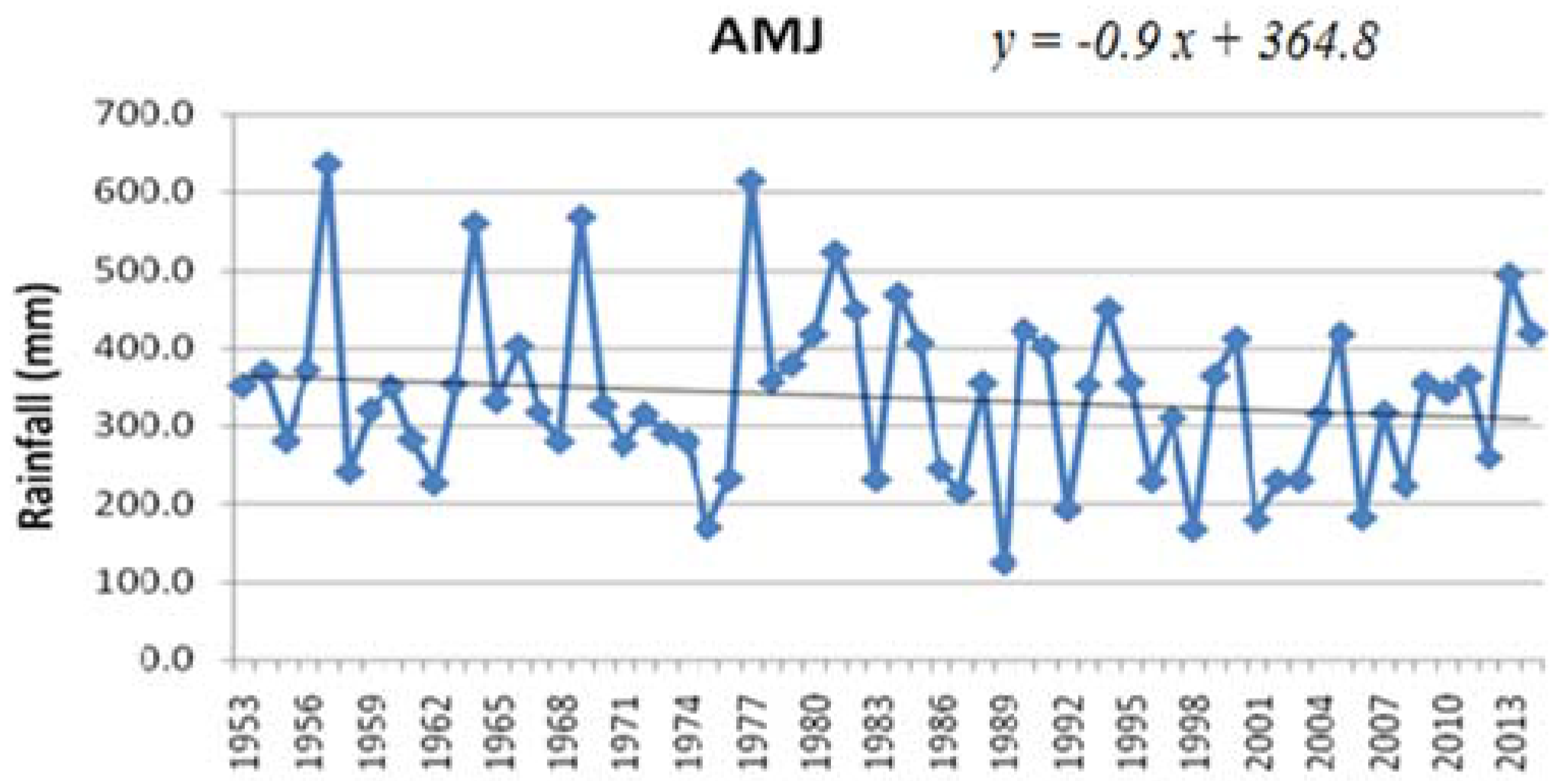
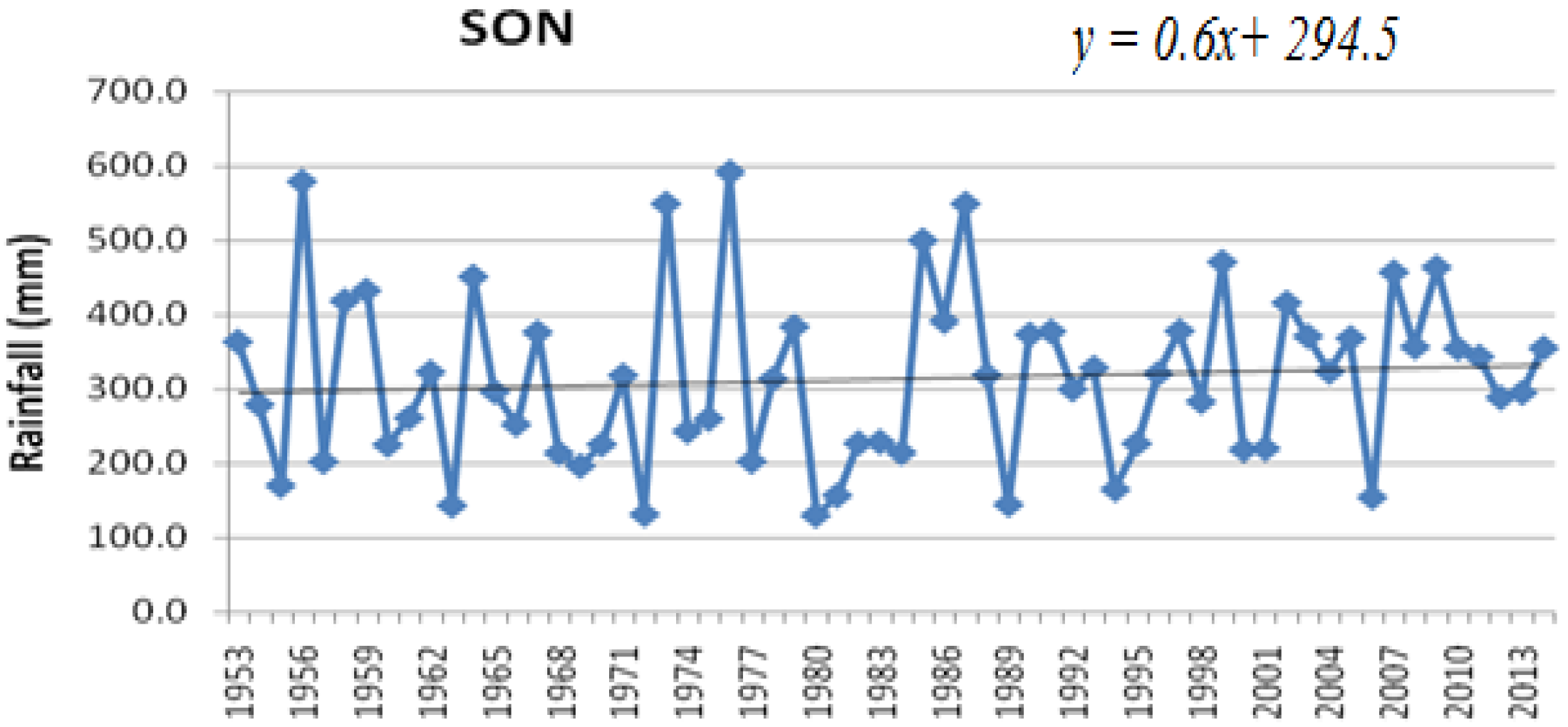
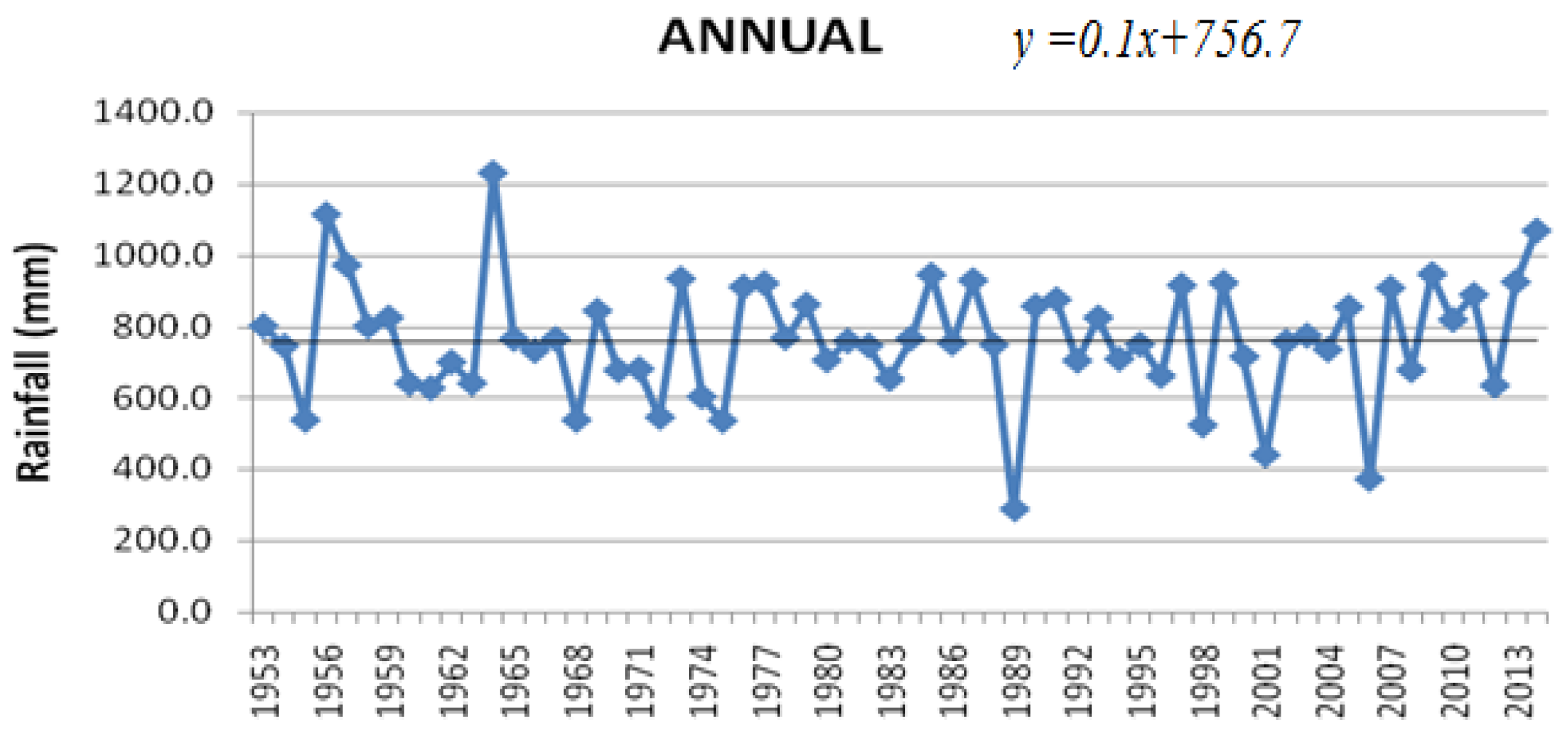
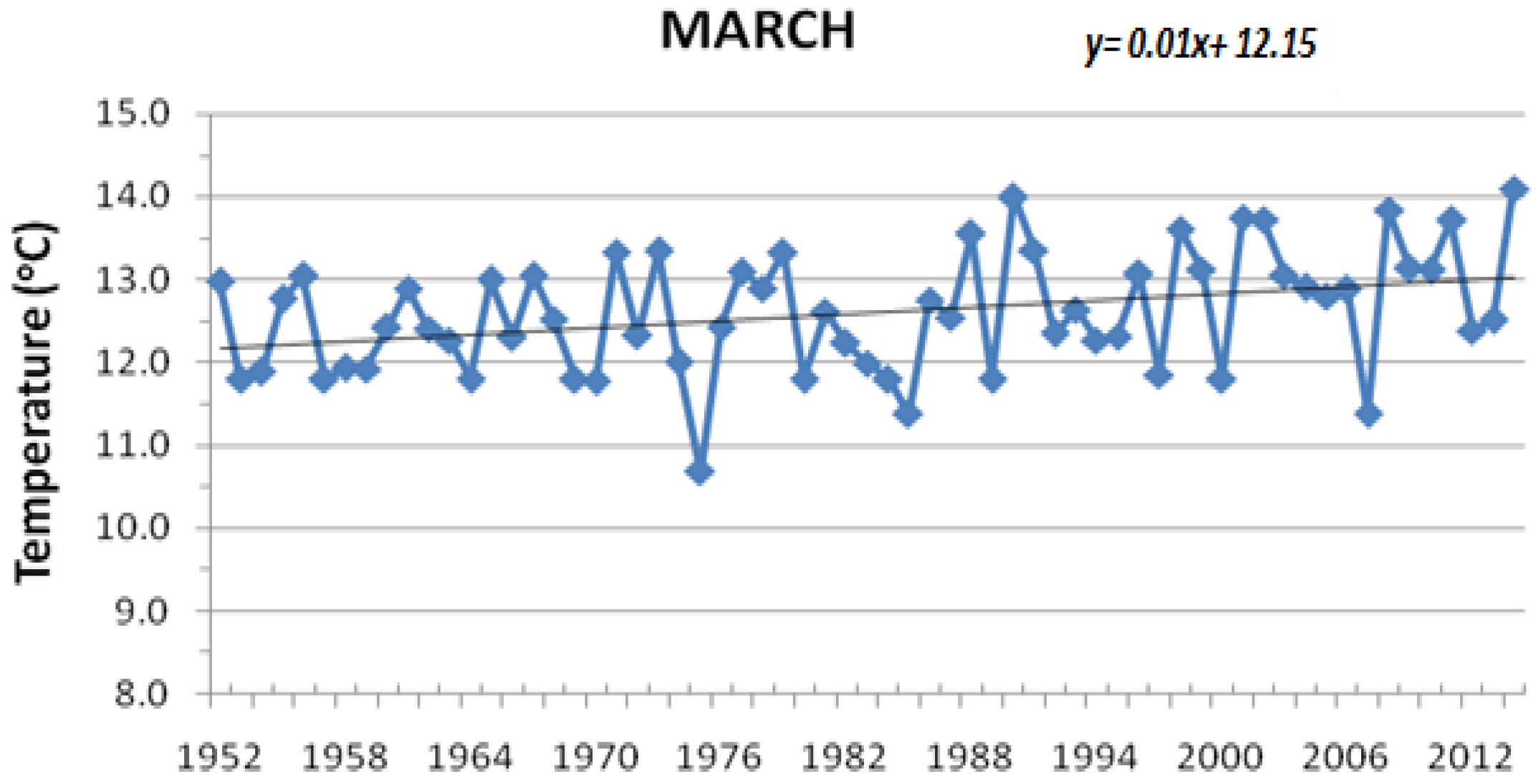
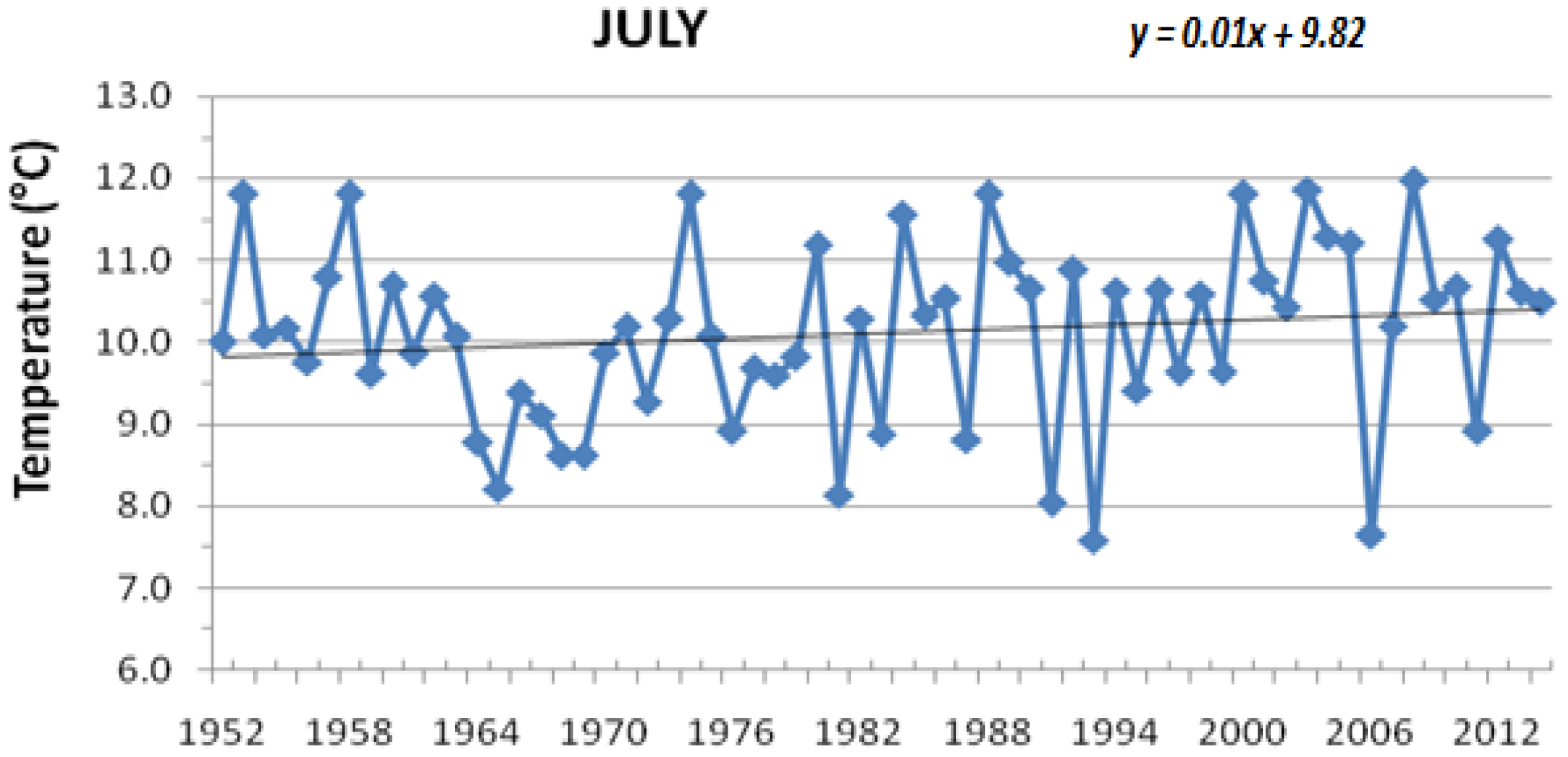
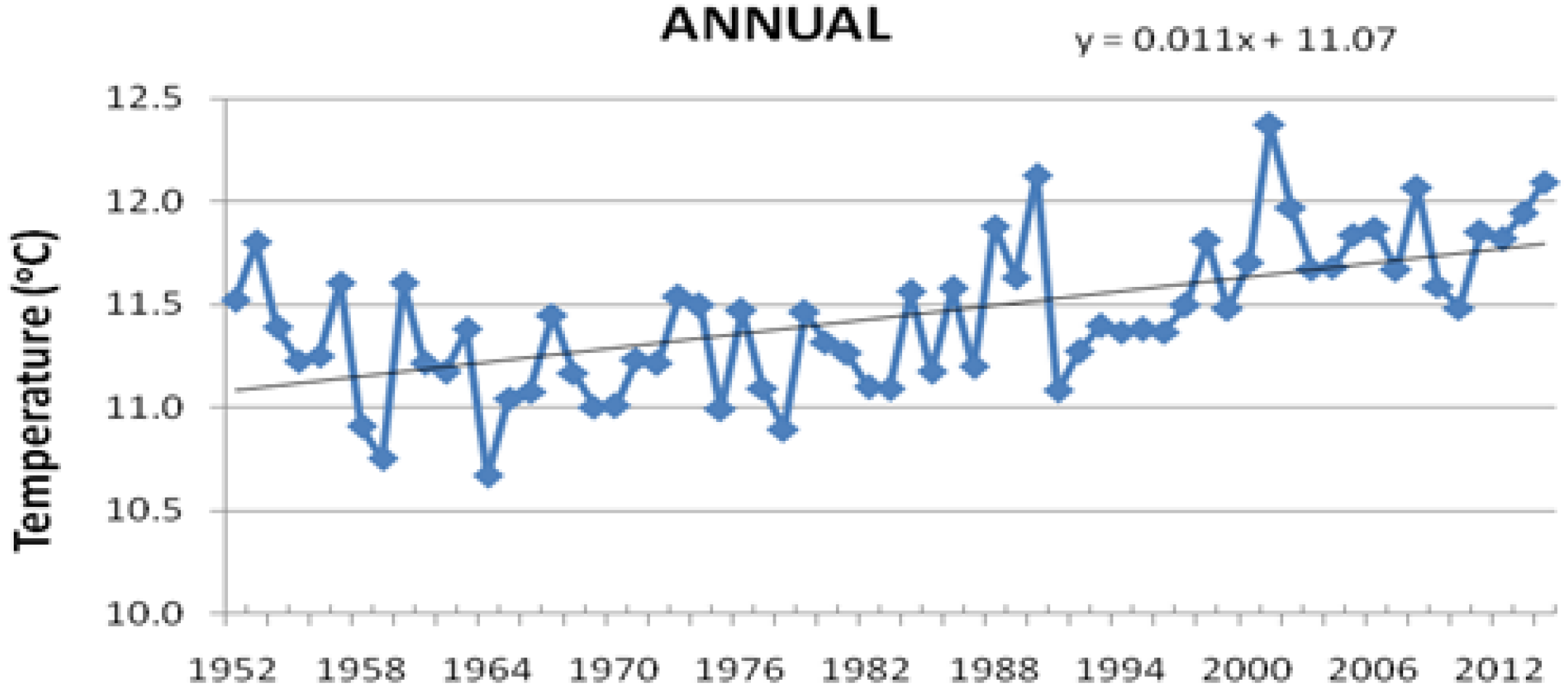
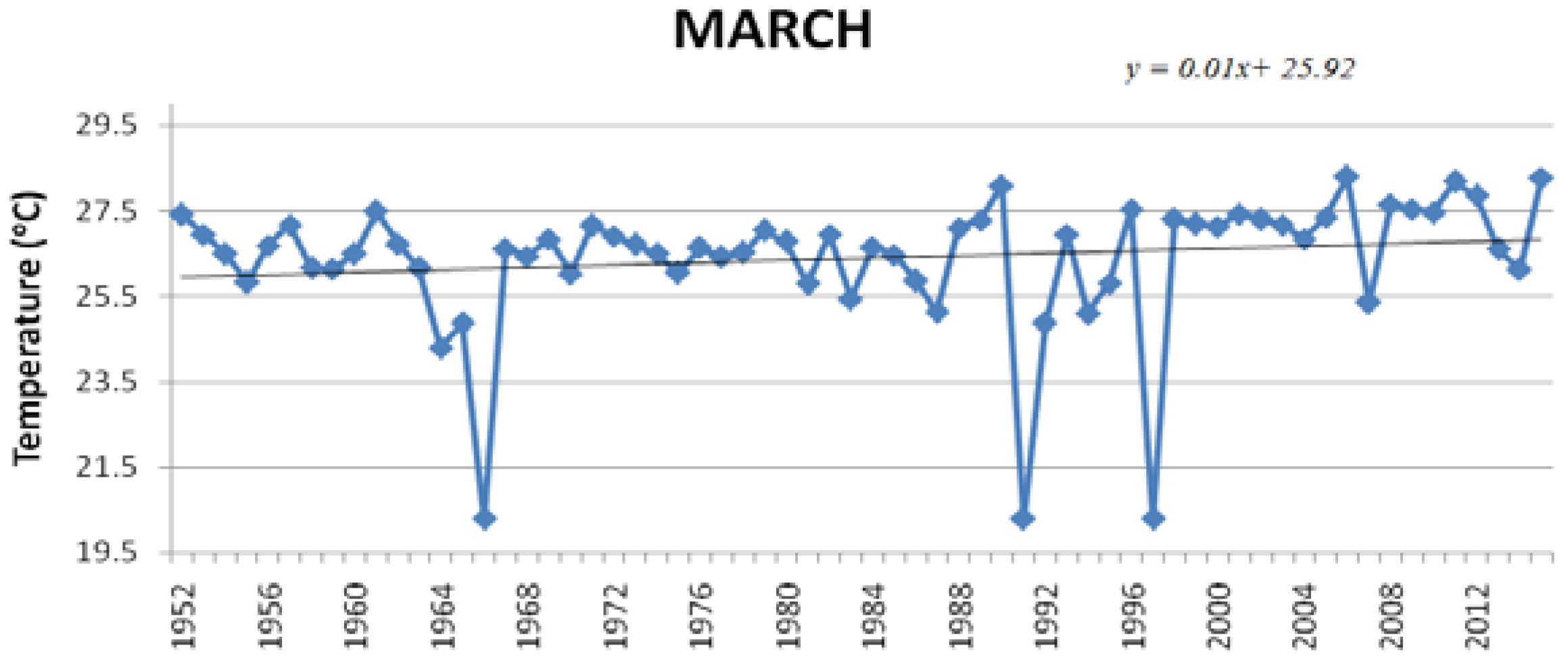
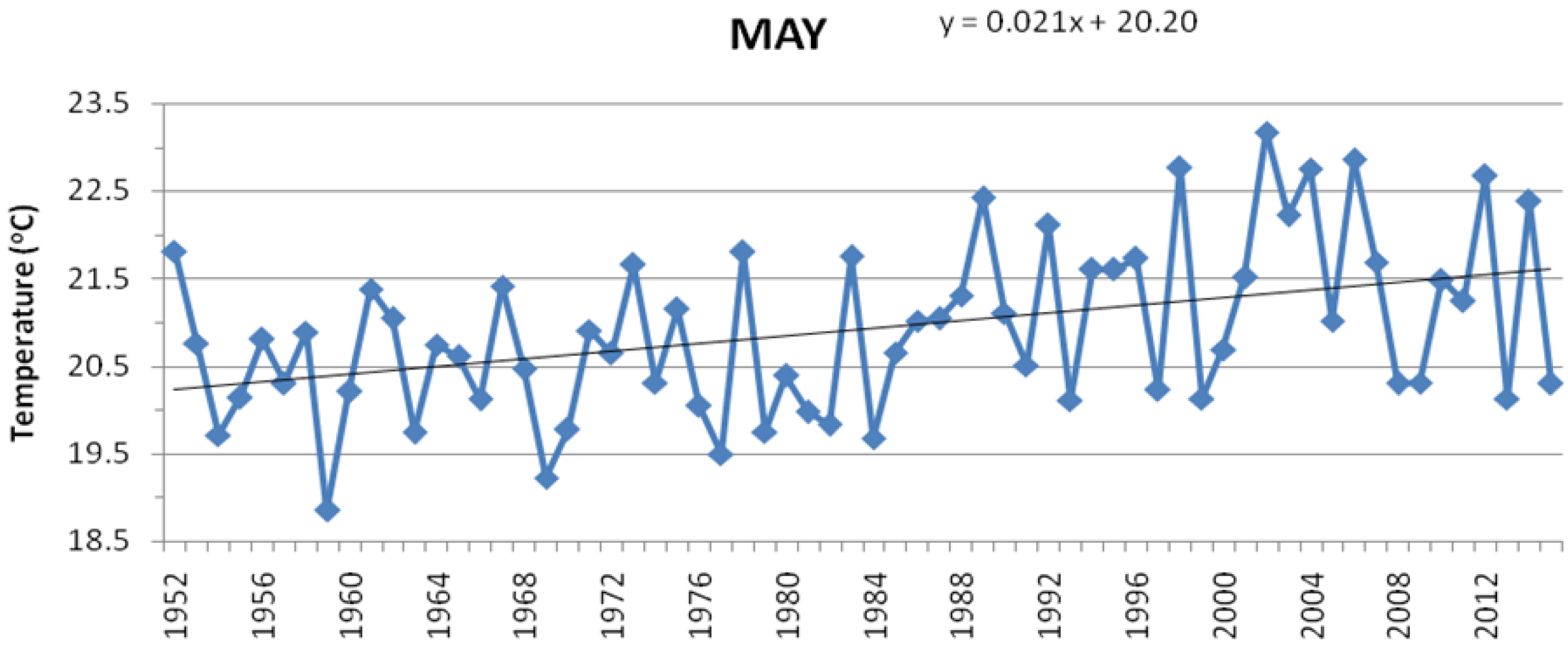
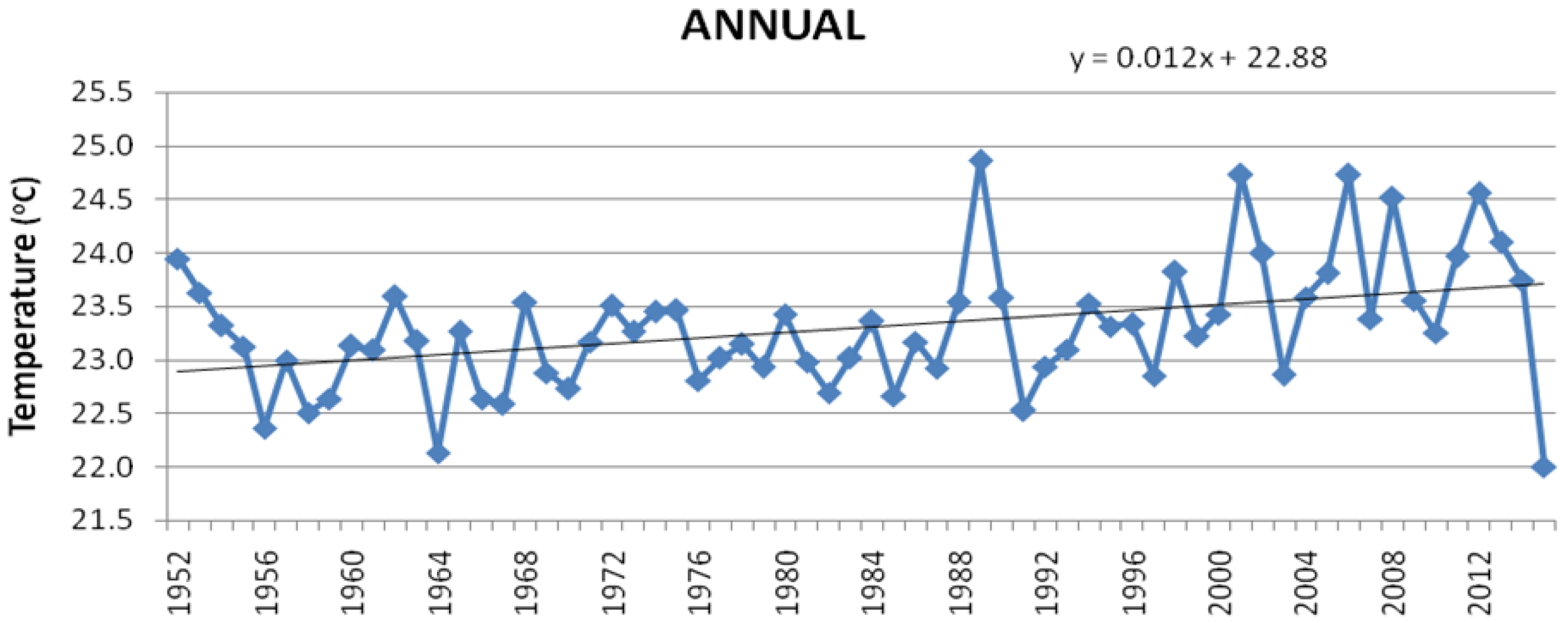
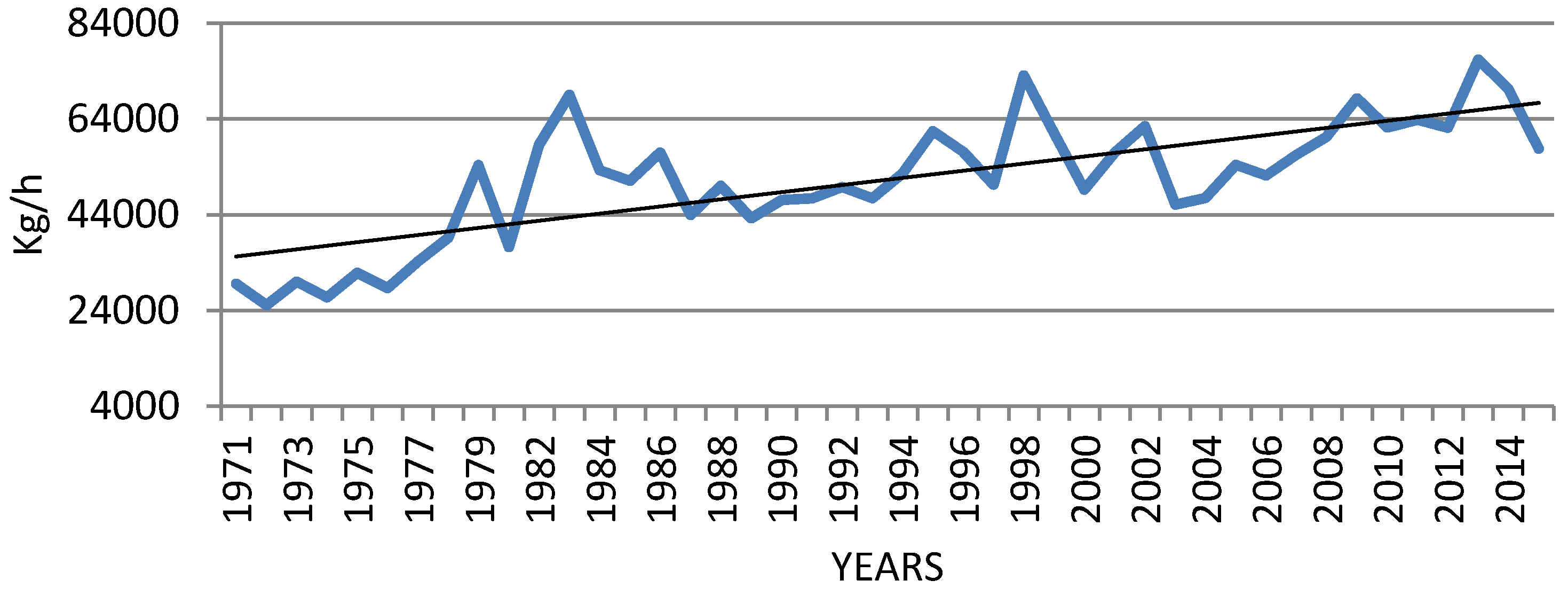
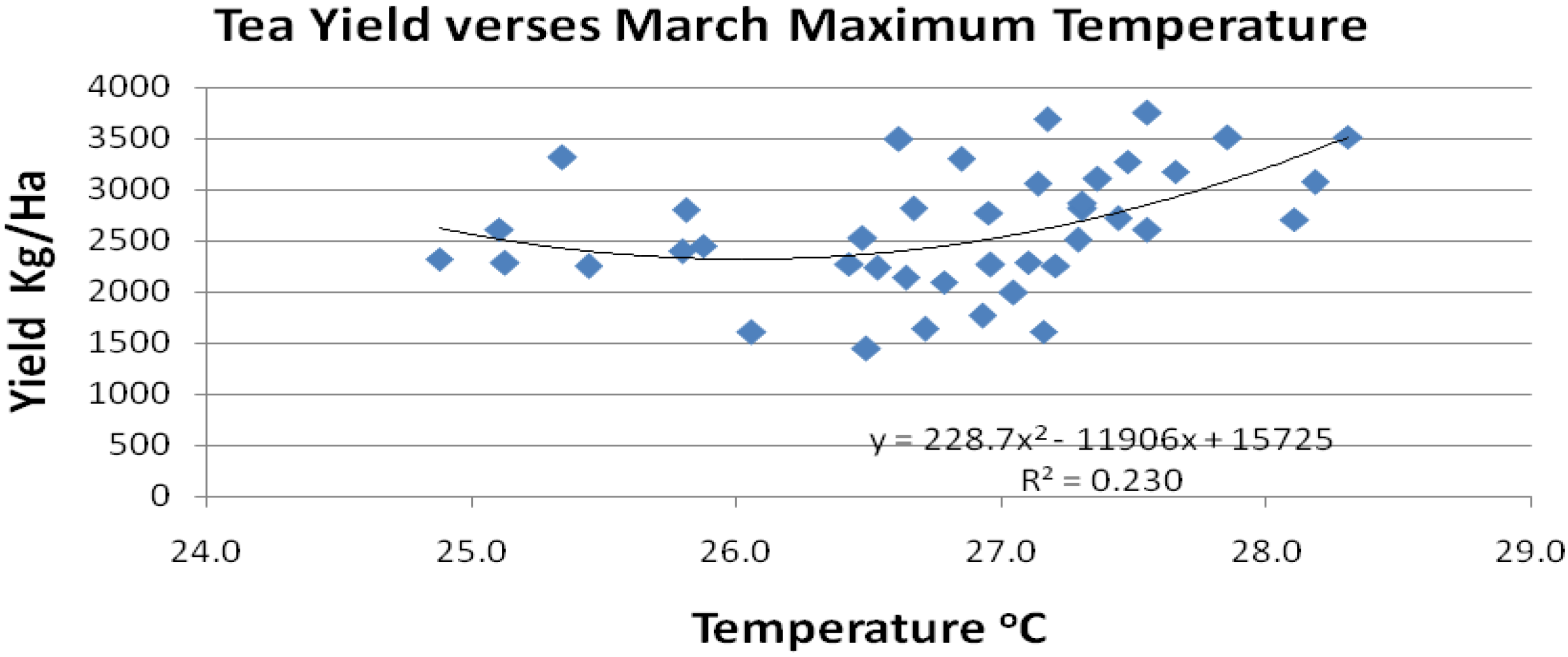
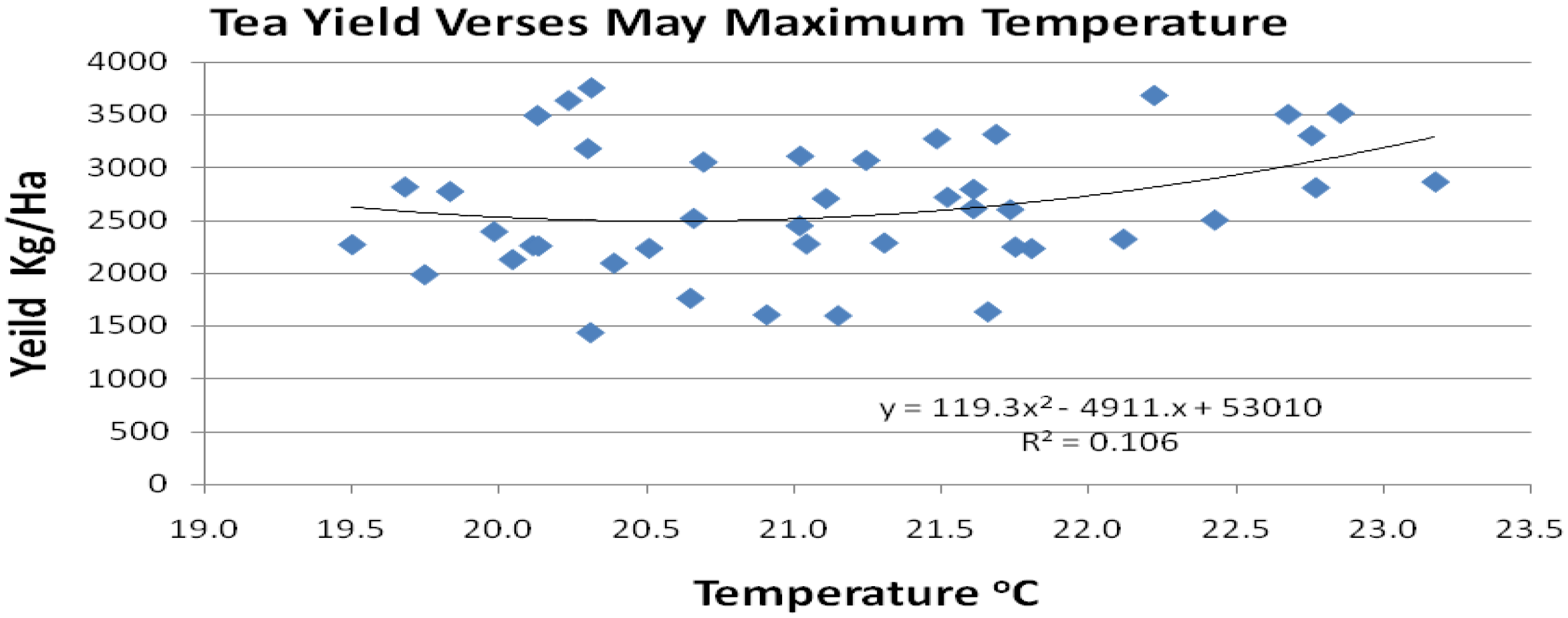


| AMJ | SON | ANNUAL | |
|---|---|---|---|
| MEAN-1 | 357.70 | 294.43 | 758.21 |
| SKEWNESS-1 | 0.97 | 0.94 | 0.96 |
| MEAN-2 | 315.65 | 332.47 | 761.70 |
| SKEWNESS-2 | −0.14 | −0.03 | −1.04 |
| MARCH | JULY | ANNUAL | |
|---|---|---|---|
| MEAN-1 | 12.4 | 9.9 | 11.2 |
| SKEWNESS-1 | −0.37 | 0.30 | −0.02 |
| MEAN-2 | 12.8 | 10.4 | 11.7 |
| SKEWNESS-2 | −0.20 | −1.00 | 0.17 |
| MARCH | MAY | ANNUAL | |
|---|---|---|---|
| MEAN-1 | 26.3 | 20.5 | 23.1 |
| SKEWNESS-1 | −3.52 | 0.04 | −0.18 |
| MEAN-2 | 26.5 | 21.3 | 23.5 |
| SKEWNESS-2 | −2.40 | 0.22 | 0.21 |
| Month | Year Before | Concurrent Year | ||||
|---|---|---|---|---|---|---|
| Minimum Temperature | Maximum Temperature | Rainfall | Minimum Temperature | Maximum Temperature | Rainfall | |
| January | 0.258 | 0.072 | −0.110 | 0.245 | 0.114 | −0.156 |
| February | 0.281 | 0.022 | 0.070 | 0.253 | −0.020 | 0.095 |
| March | 0.401 | 0.144 | 0.164 | 0.124 | 0.077 | −0.076 |
| April | 0.232 | 0.082 | 0.030 | 0.208 | 0.236 | 0.031 |
| May | 0.344 | 0.394 | −0.011 | 0.375 | 0.270 | 0.068 |
| June | 0.242 | 0.440 | −0.148 | 0.259 | 0.295 | −0.113 |
| July | 0.130 | 0.326 | 0.309 | 0.150 | 0.245 | 0.238 |
| August | 0.224 | 0.126 | −0.042 | 0.286 | 0.039 | 0.072 |
| September | 0.347 | 0.188 | 0.160 | 0.377 | 0.078 | 0.061 |
| October | 0.298 | 0.098 | 0.055 | 0.209 | 0.242 | −0.027 |
| November | 0.156 | 0.031 | 0.113 | 0.243 | 0.195 | 0.066 |
| December | 0.145 | 0.179 | −0.010 | 0.222 | 0.157 | 0.066 |
| Forecast | |||||||
|---|---|---|---|---|---|---|---|
| B | N | A | M-TOTALS | ||||
| B | 5 | 4 | 1 | 10 | |||
| OBSERVED | N | 0 | 6 | 4 | 10 | ||
| A | 0 | 3 | 17 | 20 | |||
| 5 | 13 | 22 | 40 | ||||
| Percent Correct | 70.0 | B | N | A | |||
| Post agreement (%) | 100 | 46.2 | 77.3 | ||||
| FAR (%) | 0 | 22.7 | |||||
| POD-HIT RATE (%) | 50 | 60 | 85 | ||||
| BIAS | 0.5 | 1.3 | 1.1 | ||||
| CSI | 0.5 | 0.35 | 0.68 | ||||
| HSS | 0.51 | ||||||
© 2017 by the authors. Licensee MDPI, Basel, Switzerland. This article is an open access article distributed under the terms and conditions of the Creative Commons Attribution (CC BY) license (http://creativecommons.org/licenses/by/4.0/).
Share and Cite
Sitienei, B.J.; Juma, S.G.; Opere, E. On the Use of Regression Models to Predict Tea Crop Yield Responses to Climate Change: A Case of Nandi East, Sub-County of Nandi County, Kenya. Climate 2017, 5, 54. https://doi.org/10.3390/cli5030054
Sitienei BJ, Juma SG, Opere E. On the Use of Regression Models to Predict Tea Crop Yield Responses to Climate Change: A Case of Nandi East, Sub-County of Nandi County, Kenya. Climate. 2017; 5(3):54. https://doi.org/10.3390/cli5030054
Chicago/Turabian StyleSitienei, Betty J., Shem G. Juma, and Everline Opere. 2017. "On the Use of Regression Models to Predict Tea Crop Yield Responses to Climate Change: A Case of Nandi East, Sub-County of Nandi County, Kenya" Climate 5, no. 3: 54. https://doi.org/10.3390/cli5030054






